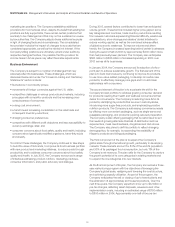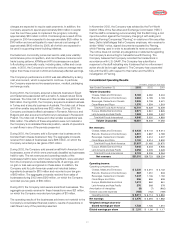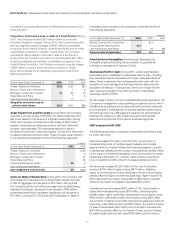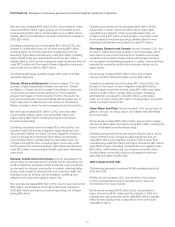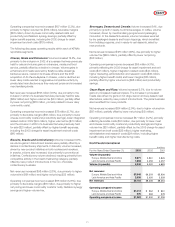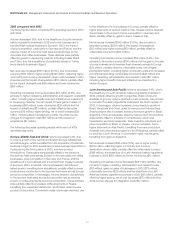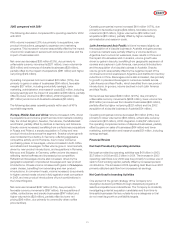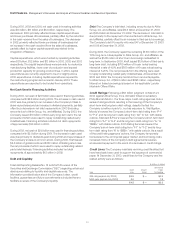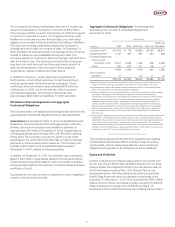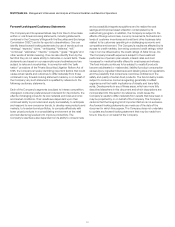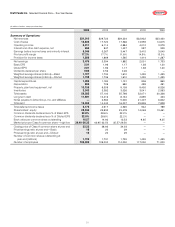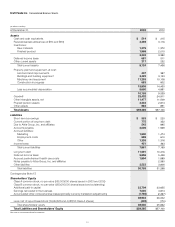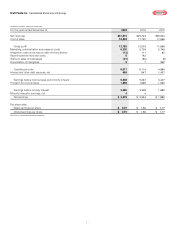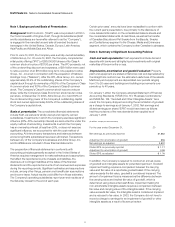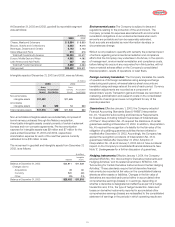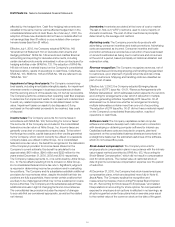Kraft 2003 Annual Report Download - page 38
Download and view the complete annual report
Please find page 38 of the 2003 Kraft annual report below. You can navigate through the pages in the report by either clicking on the pages listed below, or by using the keyword search tool below to find specific information within the annual report.
Kraft Foods Inc. Management’s Discussion and Analysis of Financial Condition and Results of Operations
new $700 million Class A common stock repurchase authority
approved by its Board of Directors in 2003. Through December 31,
2003, repurchases under the $700 million program were 1,583,600
shares at a cost of $50 million, or $31.57 per share. During 2003,
Kraft repurchased 12.5 million shares at a cost of $380 million, and in
2002 Kraft repurchased 4.4 million shares at a cost of $170 million.
Concurrently with the IPO, certain employees of Altria Group, Inc.
and its subsidiaries received a one-time grant of options to purchase
shares of Kraft’s Class A common stock held by Altria Group, Inc. at
the IPO price of $31.00 per share. In order to completely satisfy this
obligation, Altria Group, Inc. purchased 1.6 million shares of Kraft’s
Class A common stock in open market transactions during 2002.
During the first quarter of 2003, the Company granted shares of
restricted stock and rights to receive shares of stock to eligible
employees, giving them in most instances all of the rights of
stockholders, except that they may not sell, assign, pledge or
otherwise encumber such shares and rights. Such shares and
rights are subject to forfeiture if certain employment conditions are
not met. During the first quarter of 2003, the Company granted
approximately 3.7 million restricted Class A shares to eligible U.S.-
based employees and also issued to eligible non-U.S. employees
rights to receive approximately 1.6 million Class A equivalent shares.
Restrictions on the stock and rights lapse in the first quarter of 2006.
The market value per restricted share or right was $36.56 on the
date of grant.
The fair value of the shares of restricted stock and rights to receive
shares of stock at the date of grant is amortized to expense ratably
over the restriction period. The Company recorded compensation
expense related to the restricted stock and rights of $57 million
for the year ended December 31, 2003. The unamortized portion,
which is reported on the consolidated balance sheet as a reduction
of earnings reinvested in the business, was $129 million at December
31, 2003.
Dividends paid in 2003 and 2002 were $1,089 million and $936 mil-
lion, respectively, reflecting a higher dividend rate in 2003, partially
offset by lower shares outstanding as a result of Class A share
repurchases. During the third quarter of 2003, Kraft’s Board of
Directors approved a 20% increase in the quarterly dividend rate
to $0.18 per share on its Class A and Class B common stock. As a
result, the present annualized dividend rate is $0.72 per common
share. The declaration of dividends is subject to the discretion of
Kraft’s Board of Directors and will depend on various factors,
including the Company’s net earnings, financial condition, cash
requirements, future prospects and other factors deemed relevant
by Kraft’s Board of Directors.
Market Risk
The Company operates globally, with manufacturing and sales
facilities in various locations around the world, and utilizes
certain financial instruments to manage its foreign currency
and commodity exposures, which primarily relate to forecasted
transactions. Derivative financial instruments are used by the
Company, principally to reduce exposures to market risks resulting
from fluctuations in foreign exchange rates and commodity prices
by creating offsetting exposures. The Company is not a party
to leveraged derivatives and, by policy, does not use financial
instruments for speculative purposes.
Substantially all of the Company’s derivative financial instruments
are effective as hedges. During the year ended December 31, 2003,
ineffectiveness related to cash flow hedges resulted in a gain of
$13million, which was recorded in cost of sales on the consolidated
statement of earnings. Ineffectiveness related to cash flow hedges
during the year ended December 31, 2002 was not material.
At December 31, 2003, the Company was hedging forecasted
transactions for periods not exceeding twelve months and
expects substantially all amounts reported in accumulated
other comprehensive earnings (losses) to be reclassified to the
consolidated statement of earnings within the next twelve months.
Foreign Exchange Rates: The Company uses forward foreign
exchange contracts and foreign currency options to mitigate its
exposure to changes in foreign currency exchange rates from third-
party and intercompany forecasted transactions. The primary
currencies to which the Company is exposed, based on the size
and location of its businesses, include the euro, Swiss franc, British
pound and Canadian dollar. At December 31, 2003 and 2002, the
Company had option and forward foreign exchange contracts with
aggregate notional amounts of $2,486 million and $575 million,
respectively, which are comprised of contracts for the purchase and
sale of foreign currencies. The effective portion of unrealized gains
and losses associated with forward contracts is deferred as a
component of accumulated other comprehensive earnings (losses)
until the underlying hedged transactions are reported on the
Company’s consolidated statement of earnings.
36


